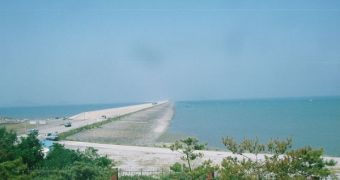The Saemangeum dam, on the coast of the Yellow Sea in South Korea, is a 33 kilometer (20.5 miles) long sea wall that, since 2006, keeps ocean waters from entering a newly-recovered, 400 square km area of land, in the province of Jeollabuk-do. Several previous administrations supported the project, which has received numerous criticisms over the years, regarding its impact on the environment.
The wetlands that once reigned in the area were crucial for flood control, and as feeding grounds for endangered bird species, on their way to and from Alaska and Russia. The Nordmann's Greenshank and Spoon-billed Sandpiper, two bird species with less than 1,000 surviving individuals, were severely affected in the two years the project has been up and running, although the government of South Korea claims that the environmental impact has been well assessed before construction started.
Saemangeum development authority official, Park Hyoungbae, said that "This project is not about protecting the environment. It is about economic development. And we will do that in an environmentally sound way." "Saemangeum will turn Korea into a much happier place," says one of the hundreds of ads running on TV, aimed at attracting as many new investors for the area as possible.
The proposal for this reclamation project has been around for several decades, but slow bureaucracy in the country has prevented it from moving along quicker. Construction began in 1999, when companies began dumping massive boulders into the water, creating the base for the new sea wall. The stones were as large as compact cars, meaning that tens of thousands of them had to be used over the years. The construction was officially over in 2006.
"The government is calling this environmentally friendly, but just planting a few trees that have since died does not make it a green project," said Green Korea conservative group representative, Yoon Sang-hoon. "Saemangeum's ecological importance seems to be more valued abroad."

 14 DAY TRIAL //
14 DAY TRIAL //